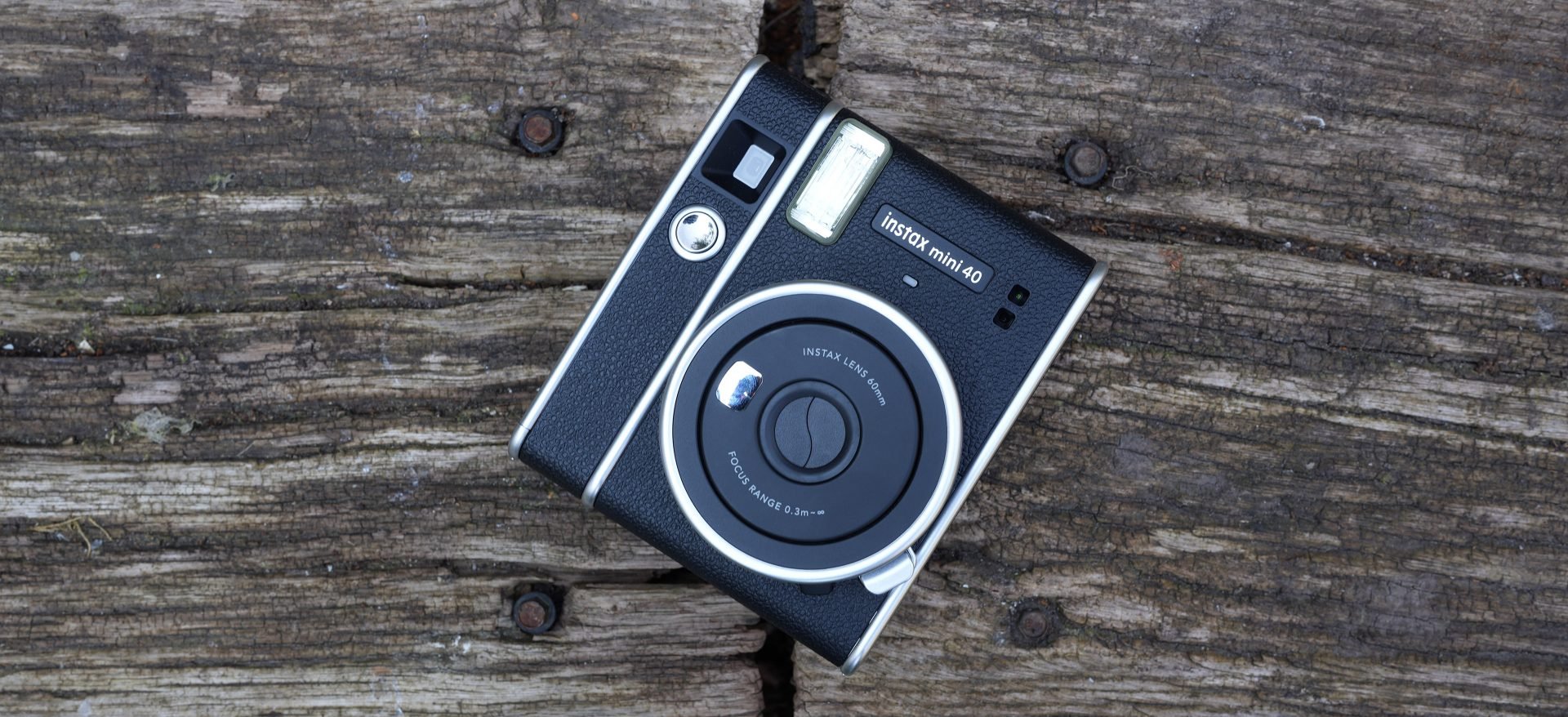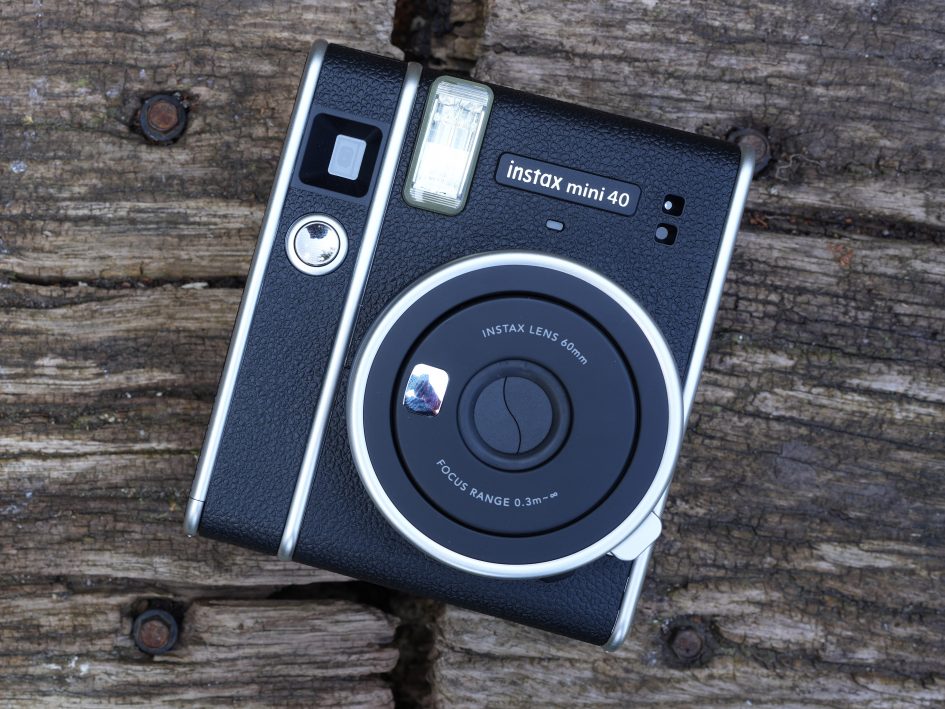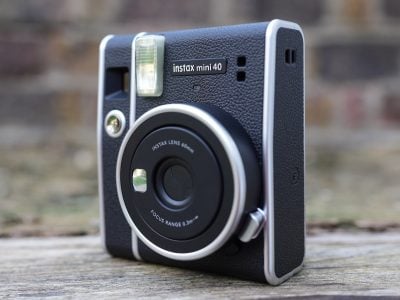Fujifilm INSTAX Mini 40 review
-
-
Written by Gordon Laing
The INSTAX Mini 40 is the latest instant camera to use Fujifilm’s enormously popular INSTAX Mini film. Launched in April 2021 and costing $99 or 89 pounds, the Mini 40 produces small prints using a fully analogue process where the paper emerges immediately after you take the shot and the image gradually fades into view roughly 90 seconds later – no need to shake it either. Find out how it compares to other INSTAX cameras and printers in my video review below, or if you prefer the written highlights, keep scrolling!
All INSTAX Mini cameras use the same INSTAX Mini film cartridges which contain ten prints and cost around 15 dollars or pounds for a twin pack, which works out around 75 cents or pence a print. Larger packs are also available and sometimes work out a bit cheaper, and Fujifilm also sells a variety with different border styles if you fancy it, as well as fully monochrome packs for fans of black and white photography.
INSTAX Mini prints are roughly business card sized, with the actual picture measuring 2.4×1.8in or 62x48mm, leaving a little room on one side for writing a note or caption.
The Mini 40 slots roughly between the Mini 11 and Mini 70 in price, although older models often enjoy greater discounting, so keep an eye open for bargains.
In terms of design, the Mini 40 is closer to the vintage style of the Mini 70 and 90, steering away from the cuter but inevitably more toy-like looks of the Mini 11. So it’s out with the Mini 11’s generous curves, choice of pastel colours and smooth finish, and in with sharper angles and a classy-looking (albeit not rubberised) black textured finish with silver detailing. If you’re into that vintage aesthetic, the Mini 40 gives it to you at a lower price than the 70 and 90.
Fujifilm also sells an optional case for the Mini 40 which continues the retro style.
But while the Mini 40 shares some of the looks of the 70 and 90, don’t expect their extended feature set. The Mini 40 doesn’t offer their greater creative options, broader exposure range, self-timer, mode screen, longer battery life or tripod threads; if you’re after the best-featured INSTAX Mini camera, then the 90 NEO Classic remains the one to beat, albeit of course at a higher price.
Instead the Mini 40 is simply a repackaged Mini 11, sharing the exact same feature-set, controls and quality. Place them side-by-side and you’ll notice most of the key parts, panels and controls are also in exactly the same positions, although the 40 swaps the slightly bulbous grip of the 11 for a flat front surface. The 40 is basically for people who want a low-cost INSTAX Mini but with more serious-looks than the 11.
Like earlier INSTAX cameras, the Mini 40 is extremely simple to use. Round the back you’ll find a large door for loading film, although do check the window first for a yellow mark which means you’ve already got a cartridge loaded; if you do, a counter towards the bottom right will tell you how many shots you have left. If the counter says S, you’re safe to open the door and load a new cartridge – just align the yellow mark on the cartridge with the one on the camera, push it inside, then close the door. Next switch on the camera by pushing the button to the corner of the lens which extends the barrel. Before you can take any photos, you’ll first need to eject the initial safety sheet, so just push the shutter button and it’ll pop out; you can throw this away. Now the counter on the rear will indicate you have ten shots remaining and you’re good to go. If your prints are coming out blank, then the cartridge has been mistakenly exposed to light.
The Mini 40 inherits the simple optical viewfinder for composing when you’re behind the camera, or a small mirror to the left of the lens for selfies; this was introduced on the Mini 9 and allows fairly effective aiming but like all analogue INSTAX cameras, expect some inaccuracies when using the viewfinder especially as you get closer to a subject. Meanwhile the flash continues to fire with every shot.
Like the 11, the Mini 40 is powered by a pair of AA batteries housed in a compartment on the grip side and good for around 100 shots, or 10 packs of film. Meanwhile a couple of small holes on the left and right sides allow you to either thread through the supplied hand-strap, or a traditional shoulder / neck strap. Sadly there’s still no tripod thread, leaving that as a feature of the 70 and 90.
Like all INSTAX Mini cameras so far, the Mini 40 employs a 60mm lens which on Mini film delivers coverage equivalent to around 34mm – so that’s mild wide angle, ideal for general use from portraits and selfies to buildings and landscapes.
Again like the Mini 11, you’ll need to push a button in the corner to power-on and extend the lens barrel for use. As standard, the lens can focus between about half a meter to infinity, but like the Mini 11, you can manually pull-out the lens a little more to enable selfie-mode with a closer focusing range of 30 to 50cm – much easier than having to remember the little lens accessory with the Mini 9.
The Mini 40 also handles exposures in exactly the same way as the Mini 11. So the lens aperture remains fixed and the shutter speed automatically varies between 1/250 and half a second, giving both models a broader range than the Mini 9, albeit lacking the slightly faster top speed of the Mini 70 and 90, or indeed the longer Bulb exposures of the 90. The automatic exposure control of the Mini 40 and 11 is much easier and more convenient than the Mini 9 which suggested an exposure with a light and expected you to manually twist the lens aperture ring to match. But by inheriting the same exposure range of the Mini 11, the new Mini 40 will still find some conditions a little too bright, or indeed a little too dim to handle.
To put the Mini 40 to the test, I hit the streets of Brighton taking a variety of indoor and outdoor shots. Here’s the results.
As with older models, the Mini 40 excels with portraits, selfies or small group shots, and so long as the distance isn’t too far, the built-in flash will provide sufficient illumination in dim conditions.
It can be great fun at parties, events or just goofing around, with the high contrast, saturated colours and glossy finish evoking the vintage style of classic Polaroids. They look great stuck to a pin board, fridge or hung from pegs, and make fun gifts to hand out.
The highly stylised process remains best-suited to bold colours and clear details and before long you’ll get a feel for what subjects work.
But with the same insides as the Mini 11, the 40 also inherits the same issues, most notably an inability to handle bright outdoor scenes due to a modest top shutter speed. I took these three images with the Mini 40 and while it was a Sunny day, it was only Spring in the UK, not Summer in more intense regions. It’s frustrating to waste prints when they cost 75 cents or pence a throw.
I dug out some older photos I took with the Mini 11 a year earlier and you can see how it suffers to the same degree under bright conditions. This could be easily solved with faster shutter speeds, like the more expensive Mini 70 and 90 and I really hope Fujifilm equips the next budget Minis with the capability.
So like all the more affordable Minis to date, there’s a limited range of conditions where you can achieve a good-looking print that’s neither too bright and washed-out, or too dark and indistinct.
The sweetspot again is for portraits or selfies at fairly close range and not under bright sunlight, where you can rely on the flash to provide the optimal lighting. Your mileage may vary, but my favourite and most successful INSTAX photos are of people rather than places. It’s all about learning what the camera can and can’t do.
If you love the INSTAX process, there’s two more decisions to make. The first is whether to stick with the classic Mini shape or go for a camera that uses the larger Square film. The prints may be the same height as the Minis, but their square shape makes them look much larger, and I personally prefer this format. Note the Mini and Square cameras can’t switch film types. If you like the look of INSTAX Square, I’d recommend the SQ6 which not only resembles a huge Instagram logo, but packs-in greater control than the Mini 40.
The second option is to ditch the unpredictability and limited exposure range of the INSTAX cameras for an INSTAX printer instead. I took all of these images with other cameras and simply printed them using the INSTAX SP3 printer. No surprises, no failed exposures, and the chance to enjoy photos with long or wide lenses, shallow depth-of-field effects, or even retouched files. While this gives you ultimate control and eliminates waste, it does eliminate the fun of INSTAX cameras with their often unpredictable results and one-off nature. The decision is yours.
Fujifilm INSTAX Mini 40 verdict
Ultimately the INSTAX Mini 40 brings the vintage style of the higher-end models to a lower price point, making it ideal for anyone who liked the idea of the Mini 11, but just didn’t get on with its cuter appearance.
But be in no doubt the Mini 40 is simply a Mini 11 in a different coat, with both models sharing the exact same quality and features, which means inheriting the good and the bad. Like the Mini 11, the 40 will over-expose on bright sunny days and is most comfortable shooting people from close range. I’m disappointed Fujifilm didn’t boost the fastest shutter to better-cope with bright conditions or even fit a tripod thread for more flexibility, but these remain reserved for higher-end models like the 70 and 90. And while the new finish looks attractive, it’s shiny plastic not grippy rubber.
Once you get over the fact the Mini 40 is basically a Mini 11 in hipster drag though, it remains equally fun to use. As always the questions to ask yourself are whether you’d exploit the extended features of the 70 or 90, whether the Square shape is more to your taste, and whether if you’d prefer the predictability of a printer rather than a camera. For me the sweetspot remains the more capable SQ6 camera with better features and square prints, but if you’re simply after an affordable INSTAX Mini camera with more serious looks than the 11, then the 40 could be for you.
Check prices on the INSTAX Mini 40 at Amazon, B&H, WEX UK, or Calumet.de. Alternatively get yourself a copy of my In Camera book or treat me to a coffee! Thanks!
 The INSTAX Mini 40 brings the vintage style of Fujifilm’s higher-end instant cameras to a lower price point, making it ideal for anyone who liked the idea of the Mini 11, but didn’t get on with its cuter appearance. But be in no doubt the Mini 40 is simply a Mini 11 in a different coat, with both models sharing the exact same quality and features, which means the 40 will over-expose on bright sunny days and is most comfortable shooting people from close range. And while the new finish looks attractive, it’s shiny plastic not grippy rubber. Once you get over the fact the Mini 40 is basically a Mini 11 in hipster drag though, it remains equally fun to use. As always ask yourself if you’d exploit the extended features of the 70 or 90, whether the Square shape is more to your taste, and if you’d prefer the predictability of a printer rather than a camera. For me the sweetspot remains the more capable SQ6 camera with better features and square prints, but if you’re simply after an affordable INSTAX Mini camera with more serious looks than the 11, then the 40 could be for you.
The INSTAX Mini 40 brings the vintage style of Fujifilm’s higher-end instant cameras to a lower price point, making it ideal for anyone who liked the idea of the Mini 11, but didn’t get on with its cuter appearance. But be in no doubt the Mini 40 is simply a Mini 11 in a different coat, with both models sharing the exact same quality and features, which means the 40 will over-expose on bright sunny days and is most comfortable shooting people from close range. And while the new finish looks attractive, it’s shiny plastic not grippy rubber. Once you get over the fact the Mini 40 is basically a Mini 11 in hipster drag though, it remains equally fun to use. As always ask yourself if you’d exploit the extended features of the 70 or 90, whether the Square shape is more to your taste, and if you’d prefer the predictability of a printer rather than a camera. For me the sweetspot remains the more capable SQ6 camera with better features and square prints, but if you’re simply after an affordable INSTAX Mini camera with more serious looks than the 11, then the 40 could be for you.




